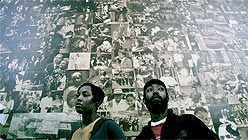Last night at a party, Micah (Wyatt Cenac) and Jo (Tracey Heggins) hooked up. Now it’s the morning after, and it’s awkward. She’s guarded, a little chilly, but he seems easy to like. He talks her into a cup of coffee. Then they share a cab. Then she bolts. But she’s left her wallet behind. He decides to track her down.
It turns out that she has a boyfriend, who’s out of town.
“Is he white?”
“Does it matter?”
“Yes and no.”
In an earlier conversation, it came out that Jo doesn’t pay rent. The boyfriend is the reason why. She guesses right that Micah is a little righteous. Underneath his open disposition, there is woundedness, anger, despair. And underneath her stricken conscience, there is affinity and real attraction.
These are the stakes in Medicine for Melancholy, local writer-director Barry Jenkins’ breezily quotidian and much-buzzed-about feature debut. And although it’s designed as one of those movies in which nothing really happens, because things happening would ruin it, stakes do get raised. Jenkins has it in mind to build a courtship around how it feels to be a minority in a gentrifying city. But not just any minority, and not just any city.
San Francisco is a character in Medicine for Melancholy, but not in a way it has been in movies before. There were a few rules going in. No trolley cars, no Golden Gate Bridge, no Fisherman’s Wharf. There are landmarks, of sorts, like the Knockout and Rainbow Grocery. But they’re landmarks for hipsters, not for tourists. The movie even has a set piece, as its characters flow through the city’s streets on the requisite fixed-gear bikes. The problem, as Micah eventually blurts in drunken desperation, is that “everything about being indie is all tied to not being black.”


